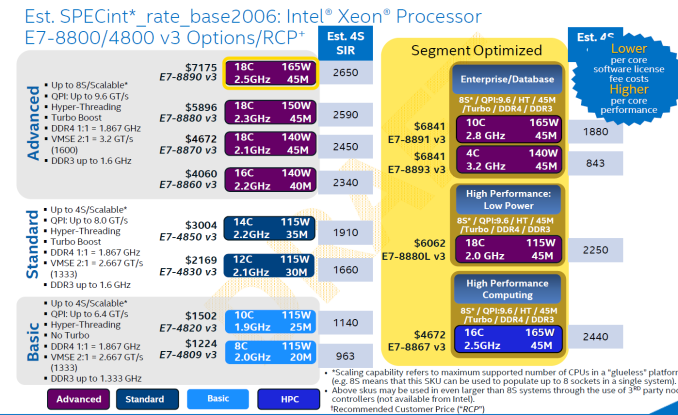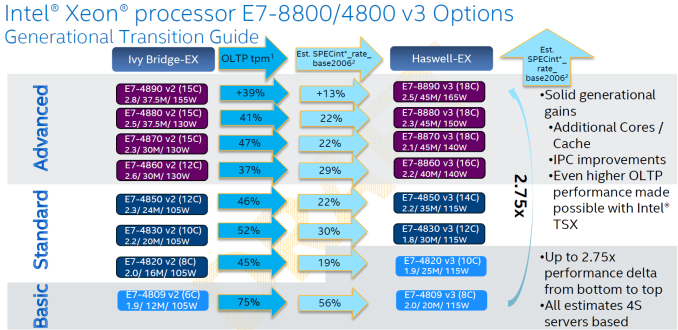The Intel Xeon E7-8800 v3 Review: The POWER8 Killer?
by Johan De Gelas on May 8, 2015 8:00 AM EST- Posted in
- CPUs
- IT Computing
- Intel
- Xeon
- Haswell
- Enterprise
- server
- Enterprise CPUs
- POWER
- POWER8
Xeon E7 v3 SKUs and prices
Intel SKU list has always been complex and very long. For reference, this is what the Xeon E7 v2 line-up looked like when it launched in 2014:
There is a scalable 2S line that is not scalable beyond 2 sockets, a frequency optimized 8857 which is probably faster in many applications than the 8893 and so on.
Luckily, with the introduction of the Xeon E7 v3, Intel simplified the SKU list.
First of all, the hardly scalable 2 socket version is gone. And at the low-end, you now get a 8-core processor at 2 GHz instead of a 6-core at 1.9 GHz. Well done, Intel.
The high-end models are all capable of running in 8 socket configurations. But the enterprise people looking for a high-end quad socket system have to pay a bit more: about 8 to 10%. Most enterprise people will not care, but getting 20% more cores (slightly improved) at 8-10% lower clocks while paying about 8% more is not exactly a vast improvement. Of course these are paper specs, but Intel used to be (a lot) more generous.
Intel's own slides confirm this. The gains in SPECint2006_rate are pretty small to justify the price increase. Intel claims higher OLTP (TPC-C) increases, but the mentioned gains are rather optimistic. For example, the HammerDB benchmark runs 29% faster on the E7-8890 v3 than on the E7-4890v2. This benchmark is much more transparant, straight forward and easier to reproduce than TPC-C, so we feel it is probably closer to the real world. Secondly, in both cases (HammerDB and TPC-C), the E7-8890v3 had twice as much memory (1 TB vs 512 GB) memory as its predecessor.
Lastly, these are benchmarks after all. In the real world systems are not running at full speed, so the gains are much smaller. So it seems that in most applications besides the TSX/AVX2 enabled ones, the gains will be rather small.













146 Comments
View All Comments
Dmcq - Saturday, May 9, 2015 - link
Well they'll sell where performance is an absolute must but they won't pose a problem to Intel as they won't take a large part of the market and they'd keep prices high. I see the main danger to Intel being in 64 bit ARMs eating the server market from below. I suppose one could have cheap and low power POWER machines to attack the main market but somehow it just seems unlikely with their background.Guest8 - Saturday, May 9, 2015 - link
Uh did you see Anandtech's reviews on the latest ARM server? The thing barely keeps up with an Avoton. Intel is well aware of ARM based servers and has preemptively disARMed the threat. If ARM could ever deliver Xeon class performance it would look like Power8.melgross - Saturday, May 9, 2015 - link
Chip TDP is mostly a concern for the chip itself. Other areas contribute far more waste heat than the CPU does.PowerTrumps - Saturday, May 9, 2015 - link
Power doesn't need to have a TDP of 1000W but 200W is nothing given the performance and efficiency advantage of the processors and Power hypervisor. When you can consolidate 2, 4 and 10 2 socket Intel servers into 1 x 2 socket Power8 server that is 10 x 2 x 135W = 2700 overall Watts vs 400W with the Power server. Power reduces the overall energy, cooling and rack space consumption.KAlmquist - Saturday, May 9, 2015 - link
$4115 E5-2699 (18C, 2.3 Ghz (3.6 Ghz turbo), max memory 768 GB)$5896 E7-8880 (18C, 2.3 Ghz (3.1 Ghz turbo), max memory 1536 GB)
That's a big premium for the E7--enough that it probably doesn't make sense to buy an 8 socket system just to run a bunch of applications in parallel. The E7 makes sense only if you need more than 36 cores to have access to the same memory.
PowerTrumps - Saturday, May 9, 2015 - link
I really enjoyed the article as well as the many data and comparison charts. It is unfortunate that most of your statements, assessments and comparisons about Power and with Intel to Power were either wrong, misleading, not fully explained or out of context. I invite the author to contact me and I will be happy to walk you through all of this so you can update this article as well as consider a future article that shows the true advantage Power8 and OpenPower truly has in the data center and the greater value available to customers.KAlmquist - Saturday, May 9, 2015 - link
I would be surprised if anybody working for Anandtech is going to contact an anonymous commentator. You can point out portions of the article that you think are wrong or misleading in this comment section.To do a really good article on Power8, Anandtech needs a vendor to give Anandtech access to a system to review.
PowerTrumps - Sunday, May 10, 2015 - link
Admittedly I assumed when I registered for the PowerTrumps account some time ago I used a email address which they could look up. But, your point is taken. Brett Murphy with Software Information Systems (aka SIS) www.thinksis.com. Email at bmurphy@thinksis.com. If I pointed out all of the mistakes my comment would look like a blog which many don't appreciate. I have my own blog for that. I like well written articles and happy to accept criticism or shortcomings with IBM Power - just use accurate data and not misrepresent anything. Before Anandtech reviews a Power8 server, my assessment is they need to understand what makes Power tick and how it is different than Intel or SPARC for that matter. Hope they contact me.thunng8 - Sunday, May 10, 2015 - link
I too would like a more detailed review of the Power8.Some of the text in the article made me laugh on how wrong they are.
For example, the great surprise that Intel is not on top.. Well anandtech has never test any Power systems before..
And it is laughable to make any conclusions based on running of 7zip. Just about any serious enterprise server benchmark shows a greater than 2x performance advantage per core in favor of Power compared to the best Xeons. So that 50% advantage is way less than expected.
Btw Power7 for most of its life bested Xeon in performance by very large margins. It is just now that IBM have opened up Power to other vendor that makes it exciting.
JohanAnandtech - Monday, May 11, 2015 - link
I welcome constructive critism. And yes, we only had access to an IBM Power8 dev machine, so we only got a small part of the machine (1 core/2GB)."Some of the text in the article made me laugh on how wrong they are."
That is pretty low. Without any pointer or argument, nobody can check your claims. Please state your concerns or mail me.